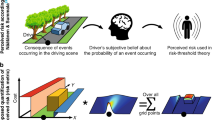Abstract
Accident risk assessment is a research field that has been started in the 60’s, in particular on the basis of «risk triangle» theory proposed by Frank E. Bird in 1969. This theory of risk uses the notion of «near misses» observation that leads to «safety rules» in a large number of application fields such as manufacturing, firemen, etc. Note that this approach is the opposite of what some automotive teams are currently starting (observing «everything» recorded on a big database): Most of the time nothing happens (no incident, no surprise). Risk experts do not do this. They are focused on «near misses» observation only, instead of observing the global process where at least 99.99% of data are not relevant for risk assessment. And observation of accidents is not relevant neither: accident is a rare combination of «near miss» situation and bad luck (stochastic process). Risk experts work on safety rules made to keep the situation as far as possible from near miss. In the domain of road safety, this approach has been developed mainly by road infrastructure experts in order to understand deep and deterministic reasons of near misses and propose ways of shaping roads and road signs in order to minimize it. This paper deals with presentation of results of a 15 years long collaborative research that extracted knowledge from road infrastructure experts and researchers, and put it into an on-board knowledge-based artificial intelligence in order to score driving risk dynamically and in real time. Indeed, there is no inherently bad driving behaviour and there is no inherently dangerous infrastructures, contrary to what many people think (black spots, harsh/brutal driving behaviour, etc.). It is when driving behaviour is inappropriate to driving context that driving risk appears. Driving context is described by infrastructure characteristics (geometry and functionality), by location of other users of the infrastructure (cars, trucks, bicycles, pedestrians, …), by weather conditions, etc. In this list, infrastructure takes 75% of the global weight, and then the artificial intelligence uses the digital map, and does pattern recognition on this digital map, in order to describe infrastructure context. ADAS sensors give additional inputs such as inter-distance, size of free space, time to collision, visibility measurement … Then driving risk depends dynamically on the context (infrastructure, traffic, visibility, …) and on the driving behaviour, through a sensor plus map fusion, made by the artificial intelligence. This artificial intelligence has been integrated inside a software API called SafetyNex that is already under deployment. This tool can alert human driver before dangerous situation, letting time to smoothly slow down and avoid potential bad surprises. Of course it can also alert the AD (Autonomous driving system) in order to automate a cautious driving behaviour (in urban areas for instance). The Artificial Intelligence estimates driving risk 20 times per second and this paper shows on real uses cases how this risk assessment anticipates potential danger. In addition, risk profiles are recorded on the cloud. We think that this risk profile recording (both for human driver and autonomous car) can be a start of comparison in terms of road safety, and a good communication vector from car manufacturers to car insurance that will need «proofs» if they ever propose a special cheap pricing. It is important as car insurers are expected to pay a part of the value brought by ADAS and autonomous vehicle because they act on risk. Of course, car insurer will accept if and only if ADAS and AD reduce accident rate and cost loss. So we conclude on the economic value of artificial intelligence in connected and intelligent cars using the cloud to exchange risk data.
Access this chapter
Tax calculation will be finalised at checkout
Purchases are for personal use only
Similar content being viewed by others
Notes
- 1.
Toward a discipline of scenario‐based architectural engineering, Rick KazmanS. Jeromy CarrièreSteven G. Woods, annals of software engineering, May 2000, Volume 9, Issue 1–4, pp. 5–33.
- 2.
Building a relevant validation database for camera-based adas, Gérard Yahiaoui & Pierre Da Silva Dias, 1st of june 2016, Conference Autonomous Vehicle Test and Development 2016, Stuttgart.
- 3.
Functional Safety: On-Board computing of Risk of Accident, Grégoire Julien, Pierre Da Silva Dias, Gérard Yahiaoui, 2 sept. 2016, Advanced Microsystems for Automotive Applications 2016 Part of the series «Lecture Notes in Mobility» pp. 175–180, Springer.
- 4.
Evaluation du risque de sortie de route pour l’aide à la conduite ou le diagnostic d’infrastructure, Johann Brunet, Pierre Da Silva Dias, Gérard Yahiaoui, 3 mai 2010, Conférence PRAC 2010 (Prévention des Risques et Aide à la Conduite)—Session caractérisation du risque routier.
- 5.
Aide embarquée à la conduite sûre et à la prévention du risque de conduite, Adil el Aboubi, Johann Brunet, Pierre Da Silva Dias, Gérard Yahiaoui, 25–26 Juin 2018, Congrès SIE «Regards Croisés sur le véhicule autonome», Paris 25 juin 2018, SIA.
Author information
Authors and Affiliations
Corresponding author
Editor information
Editors and Affiliations
Rights and permissions
Copyright information
© 2019 Springer Nature Switzerland AG
About this paper
Cite this paper
Brunet, J., DA Silva Dias, P., Yahiaoui, G. (2019). Real Time Driving Risk Assessment for Onboard Accident Prevention: Application to Vocal Driving Risk Assistant, ADAS, and Autonomous Driving. In: Langheim, J. (eds) Electronic Components and Systems for Automotive Applications . Lecture Notes in Mobility. Springer, Cham. https://doi.org/10.1007/978-3-030-14156-1_23
Download citation
DOI: https://doi.org/10.1007/978-3-030-14156-1_23
Published:
Publisher Name: Springer, Cham
Print ISBN: 978-3-030-14155-4
Online ISBN: 978-3-030-14156-1
eBook Packages: EnergyEnergy (R0)




